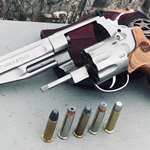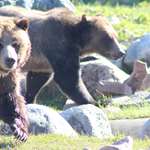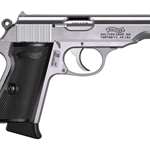
Antlers are what drive many deer hunters to the woods. Many hunters are on the never-ending quest for that “Muy Grande” that seems to exist just out of reach! Even the noble “meat” hunter would probably not pass up the opportunity to take the elusive, mature, and wise monster buck that steps out of the shadows. A New Mexico Hunting Guide once told me that if bears had antlers, he could charge twice as much for his trips!

Antlers are often incorrectly referred to as horns. Mammals with horns, such as sheep, goats, and other members of the Bovidae family, grow a bony core with a layer of blood vessels and a sheath of keratin over top. Horns often grow continuously throughout the animal's life.
On the contrary, antlers consist entirely of bone and the animal sheds and regrows them every year. Nearly all species in the Cervidae family, oftentimes referred to as the “deer family,” including white-tailed deer, mule deer, elk, moose, and caribou of North America grow antlers. Antlers are usually found on males, though females can also have them. The exception is caribou where both male and females have antlers.
As an antlered animal ages, depending on nutrition, antlers should grow larger. Exotic deer such as sika and axis may keep the same number of points on their antlers, but each year after the antlers are shed, they should grow larger. With native deer such as white-tailed and mule deer, antlers not only grow larger but also increase their number of points.

Antlers grow from the frontal plate of a deer’s skull. They grow from a pedicle into a hardened set of antlers. The pedicle acts as the base of the antler and is directly attached to the skull of the deer. As the antler grows, a “nub” pushes through the skin. Until the skin breaks, the deer is called a “button buck” or a “nubbin buck” and is considered an antlerless deer. (worlddeer.org image) This is important for hunters to know because legally, a button buck is defined as a doe, and should be tagged accordingly. An “Antlerless Deer” is a deer with no antler point protruding through the skin, or a deer that has no antlers.
As the antler grows, it is made up of bone, cartilage, fibrous tissue, skin, nerves and blood vessels. The growing antler is the fastest growing mammalian bone. It starts out as cartilage and is eventually replaced by bone. While the antler is growing, it is covered by a velvet-like skin. While the antler is growing, the deer has high nutritional needs. If these needs are met, the deer will have the best antlers available to him. If these needs are not met, the antlers will be of poor quality. Once the antler grows to its full size, the antler hardens, and the velvet dries up. The deer rubs against branches and brush, until all the velvet is rubbed off.

All animals with antlers shed and regrow them annually, typically in correlation with their breeding season and the length of daylight. However, the specific months when this process occurs vary based on where the species lives geographically. For example, whitetailed deer in North America usually shed their antlers around February and March and begin slowly regrowing them in April and May. In June, antler growth increases rapidly, up to two inches per week.
Antlers are used to attract females. The larger the rack, the more likely the male or buck will find a mate. Antlers are also used as weapons. It is not uncommon to see two males fighting over a female. These battles can be very violent leading to injury or death to one or both deer. Antler tines or points can puncture vital organs, necks can be broken, and in extreme cases, two battling males can get their antlers tangled and locked up, resulting in both animals dying from their injuries or even starvation.
Antlers have their own terminology. Each part of the antler has its own name and meaning. The following is a list of definitions associated with antlers from the Cervidae family:
Rack – A complete set of antlers.
Pedicle – The permanent base for the antlers that is attached to skull at the frontal plate.
Burr – The rough, bumpy rim at the pedicle.
Kicker – A non-typical tine that grows out of the burr or pedicle.
Main Beam – The main stem or backbone that all the tines extend from ending with the last point.
Tine – The branch that extends from the main beam. A tine must be at least 1 inch in length to be counted as a point.
Point – The tip of the tine that is counted, designating the size of the rack.
Brow Tine – The first antler tine off the main beam, usually right above the burr.
Bay Tine – The second antler tine off the main beam.
Tray Tine – The third antler tine off the main beam.
Surroyal Tine – The fourth antler tine off the main beam.
Crown – The top tine of the antler. In European Red Deer the crown is created by the fourth and fifth tine.
Cup – Another name for the crown in European Red Deer.
Drop Tine – An abnormal tine that hangs downward off the main beam.
Abnormal Tine – A tine that grows off another tine instead of the main beam. Drop tines are also considered abnormal tines.
Fork – A split into two tines located at the upper 2/3 of the main beam.
Palmed – This is when the end of the antler flattens and spreads out like an open hand. Moose antlers are probably the most well-known palmed antler although there are other species with palmed antlers such as the European Fallow Deer.
Shovel – This is when a palmed tine extends from the burr or pedicle. Caribou are known for their shovels. Two shovels on a rack are referred to as “double shovels.”
Typical – Antlers that have no abnormal tines or genetic mutations.
Non-Typical – Antlers with abnormal tines or genetic mutations.
Velvet – Antlers in the pre-calcified growth stage. This is when the antlers are still growing or “alive” and have blood flow under a “fuzzy skin” outer covering.
Western Count – The method of counting points where each antler is described. For example, if an elk has 5-points on each side it is designated as a 5X5. If a mule deer has 4 points on one side and 5 points on the other, it is designated as a 5X4.
Standard Count – The method of counting the points on each antler and adding them together. For example, if a white-tailed deer has 5 points on each antler, it is designated as a 10-pointer. If a white-tailed deer had 5 points on one side and 4 points on the other, it is designated as a 9-pointer.
Dichotomous Antlers – This is when antler tines branch or fork into equal or near equal lengths. This is a characteristic of mule deer antlers. Mule deer antlers branch at the bay tine and other tines. The crown tine also forks with near equal lengths.














































